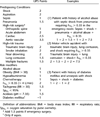Emerging therapies for the prevention of acute respiratory distress syndrome
- PMID: 26002528
- PMCID: PMC4659368
- DOI: 10.1177/1753465815585716
Emerging therapies for the prevention of acute respiratory distress syndrome
Abstract
The development of acute respiratory distress syndrome (ARDS) carries significant risk of morbidity and mortality. To date, pharmacological therapy has been largely ineffective for patients with ARDS. We present our personal review aimed at outlining current and future directions for the pharmacological prevention of ARDS. Several available risk-stratification or prediction score strategies for identification of patients at risk of ARDS have been reported. Although not ready for clinical everyday use, they are and will be instrumental in the ongoing and future trials of pharmacoprevention of ARDS.Several systemic medications established the potential role in ARDS prevention based on the preclinical studies and observational data. Due to potential for systemic adverse effects to neutralize any pharmacological benefits of systemic therapy, inhaled medications appear particularly attractive candidates for ARDS prevention. This is because of their direct delivery to the site of proposed action (lungs), while the pulmonary epithelial surface is still functional.We postulate that overall morbidity and mortality rates from ARDS in the future will be contingent upon decreasing the overall incidence of ARDS through effective identification of those at risk and early application of proven supportive care and pharmacological interventions.
Keywords: acute respiratory distress syndrome; pharmacology; prevention.
© The Author(s), 2015.
Conflict of interest statement
Figures
Similar articles
-
Fifty Years of Research in ARDS. Is Acute Respiratory Distress Syndrome a Preventable Disease?Am J Respir Crit Care Med. 2017 Mar 15;195(6):725-736. doi: 10.1164/rccm.201609-1767CI. Am J Respir Crit Care Med. 2017. PMID: 28040987 Review.
-
Prevention of acute respiratory distress syndrome.Curr Opin Crit Care. 2015 Feb;21(1):82-90. doi: 10.1097/MCC.0000000000000174. Curr Opin Crit Care. 2015. PMID: 25501020 Free PMC article. Review.
-
Pharmacological therapies for acute respiratory distress syndrome.Curr Opin Crit Care. 2014 Feb;20(1):113-21. doi: 10.1097/MCC.0000000000000056. Curr Opin Crit Care. 2014. PMID: 24335654 Review.
-
Emerging pharmacological therapies for prevention and early treatment of acute lung injury.Semin Respir Crit Care Med. 2013 Aug;34(4):448-58. doi: 10.1055/s-0033-1351118. Epub 2013 Aug 11. Semin Respir Crit Care Med. 2013. PMID: 23934714 Review.
-
Who cares about preventing acute respiratory distress syndrome?Am J Respir Crit Care Med. 2015 Feb 1;191(3):255-60. doi: 10.1164/rccm.201408-1574CP. Am J Respir Crit Care Med. 2015. PMID: 25478722
Cited by
-
Lugrandoside attenuates LPS-induced acute respiratory distress syndrome by anti-inflammation and anti-apoptosis in mice.Am J Transl Res. 2016 Dec 15;8(12):5557-5568. eCollection 2016. Am J Transl Res. 2016. PMID: 28078026 Free PMC article.
-
Are losartan and imatinib effective against SARS-CoV2 pathogenesis? A pathophysiologic-based in silico study.In Silico Pharmacol. 2020 Dec 4;9(1):1. doi: 10.1007/s40203-020-00058-7. eCollection 2021. In Silico Pharmacol. 2020. PMID: 33294307 Free PMC article.
-
25-Hydroxycholesterol protects against acute lung injury via targeting MD-2.J Cell Mol Med. 2018 Nov;22(11):5494-5503. doi: 10.1111/jcmm.13820. Epub 2018 Aug 9. J Cell Mol Med. 2018. PMID: 30091835 Free PMC article.
-
Inflammation and Monocyte Recruitment due to Aging and Mechanical Stretch in Alveolar Epithelium are Inhibited by the Molecular Chaperone 4-phenylbutyrate.Cell Mol Bioeng. 2018 Dec;11(6):495-508. doi: 10.1007/s12195-018-0537-8. Epub 2018 Jun 19. Cell Mol Bioeng. 2018. PMID: 30581495 Free PMC article.
-
The preventive effect of antiplatelet therapy in acute respiratory distress syndrome: a meta-analysis.Crit Care. 2018 Mar 8;22(1):60. doi: 10.1186/s13054-018-1988-y. Crit Care. 2018. PMID: 29519254 Free PMC article. Review.
References
-
- Acute Respiratory Distress Syndrome Network. Ventilation with lower tidal volumes as compared with traditional tidal volumes for acute lung injury and the acute respiratory distress syndrome. The New England journal of medicine. 2000;342(18):1301–1308. - PubMed
-
- Arnaud C, Veillard NR, et al. Cholesterol-independent effects of statins in inflammation, immunomodulation and atherosclerosis. Current drug targets. Cardiovascular & haematological disorders. 2005;5(2):127–134. - PubMed
-
- Bao S, Wang Y, et al. Keratinocyte growth factor induces Akt kinase activity and inhibits Fas-mediated apoptosis in A549 lung epithelial cells. American journal of physiology. Lung cellular and molecular physiology. 2005;288(1):L36–L42. - PubMed
Publication types
MeSH terms
Substances
Grants and funding
LinkOut - more resources
Full Text Sources
Other Literature Sources



